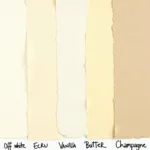Changing clothing color in Photoshop is a breeze with the right tools and techniques. Whether you’re a fashion enthusiast, aspiring designer, or just want to experiment with different looks, mastering this skill opens up a world of creative possibilities. In this guide, we’ll explore different methods to effectively change clothing color in Photoshop, giving you the power to transform your images with precision and style.
Understanding Color Selection Tools
Before diving into the techniques, let’s familiarize ourselves with the essential color selection tools in Photoshop that will help us achieve accurate and realistic results.
- Magic Wand Tool (W): This tool is ideal for selecting large areas of similar color. Its tolerance setting allows you to adjust the sensitivity of the selection, making it perfect for selecting solid-colored clothing items.
- Quick Selection Tool (W): This intuitive tool quickly selects areas based on similarity in color and texture. By simply dragging the tool over the clothing, you can create accurate selections even with complex edges.
- Lasso Tools (L): The Lasso Tools offer more control over your selections. You can use the Polygonal Lasso for straight lines, the Magnetic Lasso for snapping to edges, or the Freehand Lasso for freeform selections.
- Pen Tool (P): For precise and intricate selections, the Pen Tool is your go-to. It allows you to create custom paths by placing anchor points, resulting in highly accurate outlines.
Methods to Change Clothing Color in Photoshop
Now that we know our tools let’s explore the different methods to change clothing color in Photoshop:
1. Hue/Saturation Adjustment Layer
The Hue/Saturation adjustment layer is a quick and non-destructive way to change the overall color of your clothing.
- Open your image in Photoshop and duplicate the layer containing the clothing you want to recolor. This ensures that your original image remains untouched.
- With the duplicated layer selected, go to Layer > New Adjustment Layer > Hue/Saturation.
- Experiment with the Hue, Saturation, and Lightness sliders to achieve the desired color.
- To target specific color ranges, use the dropdown menu in the Properties panel to select individual colors like Reds, Yellows, Greens, etc., and fine-tune their respective hue, saturation, and lightness values.
2. Color Balance Adjustment Layer
The Color Balance adjustment layer allows you to adjust the color balance of your clothing by manipulating the shadows, midtones, and highlights.
- Similar to the Hue/Saturation method, duplicate the clothing layer and go to Layer > New Adjustment Layer > Color Balance.
- Adjust the Cyan/Red, Magenta/Green, and Yellow/Blue sliders for the Shadows, Midtones, and Highlights to achieve the desired color shift. For example, increasing the Magenta and Yellow sliders in the Highlights will add a warm, reddish tone.
3. Selective Color Adjustment Layer
This method offers more control by allowing you to adjust the color of specific primary colors in your image.
- Create a new Selective Color adjustment layer (Layer > New Adjustment Layer > Selective Color).
- From the Colors dropdown menu, select the color you want to modify. For example, to change the color of a blue shirt, select “Cyans.”
- Adjust the Cyan, Magenta, Yellow, and Black sliders to fine-tune the selected color.
4. Replace Color Adjustment Layer
The Replace Color adjustment layer lets you target specific colors in your image and replace them with a different color.
- Add a new Replace Color adjustment layer (Layer > New Adjustment Layer > Replace Color).
- Use the eyedropper tool to select the color you want to replace. You can adjust the fuzziness slider to broaden or narrow the range of color selection.
- Once selected, use the Hue, Saturation, and Lightness sliders to choose your desired replacement color.
5. Brush Tool and Blending Modes
For more creative control and to add unique effects, use the Brush Tool (B) in combination with blending modes.
- Create a new layer above your clothing layer.
- Select the Brush Tool and choose a soft-edged brush.
- In the Options bar, select a blending mode from the dropdown menu. Experiment with blending modes like “Color,” “Overlay,” or “Soft Light” to see how they interact with the underlying color.
- Choose your desired color and gently paint over the clothing to apply the color change. Adjust the brush opacity and flow for subtle transitions.
“When changing clothing color in Photoshop, it’s crucial to work with adjustment layers and masks to maintain a non-destructive workflow. This approach allows for flexibility and preserves the integrity of your original image.” – Maria Sanchez, Senior Graphic Designer at Creative Solutions Inc.
Tips for Realistic Color Changes
- Select carefully: Use the appropriate selection tool and refine your selection for accurate color changes.
- Work with masks: Create masks on your adjustment layers to refine the color change and target specific areas.
- Consider lighting and shadows: Pay attention to the existing lighting and shadows in the image to ensure the new color looks natural.
- Adjust saturation and brightness: Fine-tune the saturation and brightness of the new color to blend seamlessly with the rest of the image.
- Practice makes perfect: Experiment with different methods and settings to find the techniques that work best for you.
Conclusion
Mastering the art of changing clothing color in Photoshop unlocks a world of possibilities for creative expression. By understanding the tools, techniques, and tips outlined in this guide, you can confidently transform your images, experiment with different styles, and bring your fashion visions to life. Remember to practice and explore the vast capabilities of Photoshop to unleash your full creative potential.
FAQs
1. Can I change the color of clothing in a JPEG image?
Yes, you can change the color of clothing in a JPEG image using the methods described above. However, keep in mind that JPEG is a lossy format, so extensive editing might result in some quality loss.
2. What is the best method for changing the color of patterned clothing?
For patterned clothing, a combination of selection tools and adjustment layers might be necessary. Use the selection tools to isolate specific areas of the pattern and apply color changes using adjustment layers.
3. How do I make the color change look realistic?
Pay attention to the original lighting, shadows, and textures of the clothing when changing the color. Use masks to refine the color change and adjust the saturation and brightness for a seamless blend.
4. Can I use these techniques to change the color of other objects in Photoshop?
Yes, the techniques described in this guide can be applied to change the color of any object in Photoshop, not just clothing.
5. Are there online tools available for changing clothing color?
Yes, there are online tools and apps that offer basic color change functionalities. However, Photoshop provides more control and professional results for intricate edits.
Need Help Transforming Your Images?
Contact us at 0373298888 or email [email protected]. Our team of Photoshop experts is available 24/7 to assist you with all your image editing needs. Visit us at 86 Cầu Giấy, Hà Nội to discuss your project in person. We look forward to helping you bring your creative vision to life!

